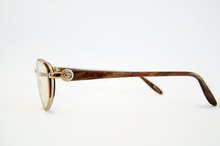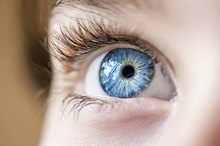What does fact checked mean?
At Healthfully, we strive to deliver objective content that is accurate and up-to-date. Our team periodically reviews articles in order to ensure content quality. The sources cited below consist of evidence from peer-reviewed journals, prominent medical organizations, academic associations, and government data.
The information contained on this site is for informational purposes only, and should not be used as a substitute for the advice of a professional health care provider. Please check with the appropriate physician regarding health questions and concerns. Although we strive to deliver accurate and up-to-date information, no guarantee to that effect is made.
The appearance of a black or dark gray spot in the center of your vision signals a serious problem that may ultimately lead to blindness. Check each eye separately by looking at a lined pattern, such as wallpaper, with one eye covered. If the lines appear wavy and you see a dark spot in the middle, the cause may be macular degeneration, and you should see an eye care professional at once.
If you are experiencing serious medical symptoms, seek emergency treatment immediately.
AMD
Age-related macular degeneration (AMD) is an eye disease that shows up as a dark gray or blurry black spot, or a hole, in the center of vision, often in one eye only 12. Over time, the progressive disease destroys central vision that is needed for reading and other close work as well as for driving and seeing distances. AMD generally does not affect side, or peripheral, vision. As the name suggests, AMD is the leading cause of vision loss in people over 60.
- Age-related macular degeneration (AMD) is an eye disease that shows up as a dark gray or blurry black spot, or a hole, in the center of vision, often in one eye only 1.
- As the name suggests, AMD is the leading cause of vision loss in people over 60.
Causes
What Eye Problems are Typical With Crohn's Disease?
Learn More
The macula is in the back of the eyeball, in the center of the retina. There are two types of AMD: wet and dry. Wet AMD results from blood vessels growing under the macula and can cause loss of central vision very quickly.
Dry AMD, the most common form, is the result of cells in the macula breaking down and blurring vision. Gradually, the affected eye loses vision.
- The macula is in the back of the eyeball, in the center of the retina.
- Wet AMD results from blood vessels growing under the macula and can cause loss of central vision very quickly.
Risks
Risk factors for AMD are age, over-exposure to sunlight (UVA rays), smoking, family history, race and gender (AMD occurs more frequently among Caucasians and women), obesity, heredity and family history, high blood pressure and having light-colored eyes.
Symptoms
How to Measure for a Trifocal Lens
Learn More
For both wet and dry AMD, a common symptom is a blind spot in the center of vision. An early sign of dry AMD is blurred vision, with details becoming difficult to distinguish. An early symptom of wet AMD is the wavy appearance of straight lines.
Evaluation
A visual acuity test, the traditional eye chart, administered by your eye care professional, will demonstrate your vision at various distances. Your eye doctor may also administer a dilated eye exam, using drops to widen your pupils, to examine the retina and optic nerve for signs of AMD as well as other eye problems. In a tonometry test, an instrument measures the pressure inside your eye.
An Amsler grid is a specific test for AMD. It is a grid-patterned chart with a black dot in the center. You will be asked to stare at the dot and notice if some of the lines appear missing or wavy.
Your eye doctor may recommend that you see a retinal specialist who will administer further tests, including a fluorescein angiogram in which a dye is injected into your arm and photos are taken that identify leaking blood vessels. The specialist can determine whether you have AMD, whether it is the wet or dry form, and whether it is in advanced or intermediate stages.
- A visual acuity test, the traditional eye chart, administered by your eye care professional, will demonstrate your vision at various distances.
- Your eye doctor may recommend that you see a retinal specialist who will administer further tests, including a fluorescein angiogram in which a dye is injected into your arm and photos are taken that identify leaking blood vessels.
Treatment
Treatments for wet AMD include laser surgery, photodynamic therapy or injections of drugs directly into the eye. Photodynamic therapy combines a photosensitizing drug and a specific type of light.
While there is no known treatment to prevent vision loss from advanced dry AMD, a high-dose formulation of antioxidants and zinc has been found to slow the progression of AMD from intermediate to advanced. The Age-Related Eye Disease Study (AREDS) recommends specific amounts of vitamins C and E, beta carotene (vitamin A), zinc and copper. The AREDS formulation can be found in over-the-counter products, but you should consult with your physician before beginning such a regimen.
- Treatments for wet AMD include laser surgery, photodynamic therapy or injections of drugs directly into the eye.
- While there is no known treatment to prevent vision loss from advanced dry AMD, a high-dose formulation of antioxidants and zinc has been found to slow the progression of AMD from intermediate to advanced.
Related Articles
References
- National Eye Institute: Facts About Age-Related Macular Degeneration
- All About Vision: Age-Related Macular Degeneration
- American Academy of Ophthalmology. Vitamins for AMD
- American Academy of Ophthalmology. Eye Health Observances
- American Academy of Ophthalmology. Macular Degeneration and Low Vision: Making the Most of Low Vision
- Boyd, Kierstan. "Macular Degeneration and Low Vision: Making the Most of Low Vision." American Academy of Ophthalmology (AAO), 13 April 2018.
Writer Bio
As a long-time newspaper reporter and staff writer, Kay Bosworth covered real estate development and business for publications in northern New Jersey. Her extensive career included serving as editor of a business education magazine for the McGraw-Hill Book Company. The Kentucky native earned a BA from Transylvania University in Lexington.








